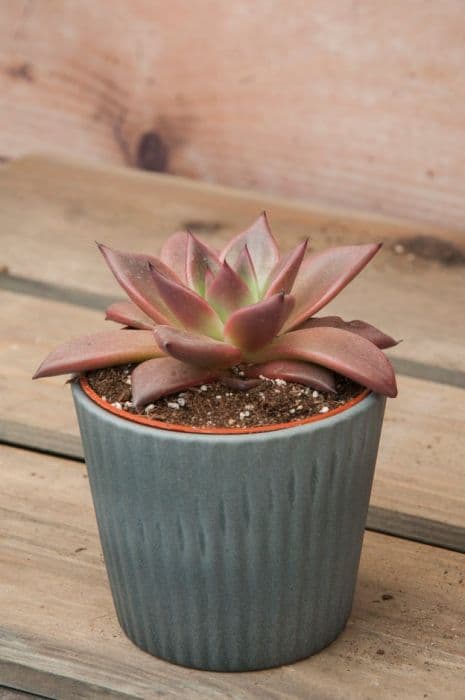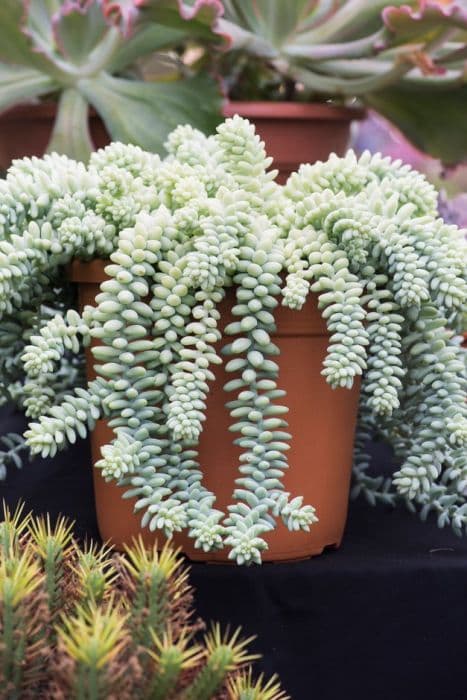Tessa Kalanchoe Kalanchoe 'Tessa'

ABOUT
Kalanchoe 'Tessa' is a succulent plant known for its attractive foliage and striking blooms. The leaves of this Kalanchoe are dark green, thick, and fleshy, often with a glossy appearance that gives the plant a robust and healthy look. They are typically arranged in a dense rosette pattern, which adds to the visual interest of the plant. What sets 'Tessa' apart are its tubular flowers that dangle elegantly in clusters. These blossoms are a vibrant shade, often found in hues of yellow, orange, or red, creating a striking contrast against the green leaves. The flowers have a bell-like shape with flared petal tips, giving them a somewhat whimsical appearance reminiscent of small lanterns. The flowering stems tend to arch gracefully, adding to the overall delicate yet luscious appearance of Kalanchoe 'Tessa'. This plant’s succulent nature means that the leaves and stems may have a somewhat plump look, indicative of their water storage capabilities. Overall, Kalanchoe 'Tessa' is a charming and colorful addition to any plant collection, with a shape and structure that is visually pleasing and easy to recognize.
About this plant
 Names
NamesFamily
Crassulaceae
Synonyms
Tessa Kalanchoe, Pendent Kalanchoe
Common names
Kalanchoe 'Tessa'.
 Toxicity
ToxicityTo humans
Kalanchoe 'Tessa', commonly known as kalanchoe, can be toxic if ingested. While toxicity levels may be relatively low for humans compared to pets, it still contains compounds that can cause adverse reactions. Eating large amounts of kalanchoe may result in symptoms such as vomiting, diarrhea, and stomach pain. It is especially important to keep kalanchoe out of reach of children who might be tempted to eat its leaves or flowers.
To pets
Kalanchoe 'Tessa', commonly referred to as kalanchoe, is toxic to pets, including cats and dogs. It contains compounds called cardiac glycosides, which can be harmful if ingested. The symptoms of kalanchoe poisoning in pets can include vomiting, diarrhea, drooling, and a noticeable change in heart rate. In severe cases, ingestion can lead to serious cardiac issues and even death. It is crucial to prevent pets from having access to this plant, and if you suspect your pet has ingested kalanchoe, seek veterinary care immediately.
 Characteristics
CharacteristicsLife cycle
Perennials
Foliage type
Evergreen
Color of leaves
Green
Flower color
Orange
Height
1 foot 4 inches (0.4 meters)
Spread
1 foot (0.3 meters)
Plant type
Succulent
Hardiness zones
10
Native area
Madagascar
Benefits
 General Benefits
General Benefits- Easy Care: The plant is known to be low-maintenance and can thrive with minimal attention, making it suitable for beginner gardeners.
- Drought Tolerant: It has a high tolerance for drought, which means it can survive with infrequent watering, conserving water resources.
- Attractive Flowers: Produces vibrant, pendulous flowers that add a splash of color to indoor or outdoor spaces.
- Long Flowering Period: Often has a lengthy blooming season, providing aesthetic appeal for an extended time.
- Compact Size: With its moderate growth habit, it is ideal for small spaces such as apartments and offices.
- Propagation Ease: It can be easily propagated from cuttings, allowing gardeners to create new plants without buying more.
 Medical Properties
Medical Properties Air-purifying Qualities
Air-purifying QualitiesThis plant is not specifically known for air purifying qualities.
 Other Uses
Other Uses- Kalanchoe 'Tessa' can be used in hanging baskets to take advantage of its trailing stems and vibrant bell-shaped flowers, adding aesthetics to balconies and patios.
- This plant can serve as a living gift alternative to cut flowers due to its long-lasting blooms and easy care, symbolizing endurance and lasting affection.
- The succulent nature of Kalanchoe 'Tessa' makes it suitable for use in water-wise gardens or xeriscaping projects, helping to conserve water.
- Kalanchoe 'Tessa' can be used in fairy gardens or miniature landscapes, providing a touch of tropical flair and an exotic look.
- Its vibrant blossoms can be used as a natural color guide or inspiration in art and design projects, providing a vivid palette of colors to work with.
- For educational purposes, Kalanchoe 'Tessa' can be used to teach children about plant growth, photosynthesis, and the life cycle of flowers.
- The plant can be incorporated into pet-safe garden areas, as Kalanchoe 'Tessa' is not known to be toxic to animals like some other Kalanchoe species.
- It can be utilized in floral arrangements and crafts by drying or pressing its colorful flowers, preserving their beauty for extended periods.
- Kalanchoe 'Tessa' can act as a natural humidifier when grouped with other plants, releasing water vapor into the air through transpiration.
- Its ease of propagation through leaf and stem cuttings can make it a helpful educational tool for propagation workshops or horticultural therapy sessions.
Interesting Facts
 Feng Shui
Feng ShuiThe plant Kalanchoe is not used in Feng Shui practice.
 Zodiac Sign Compitability
Zodiac Sign CompitabilityThe plant Kalanchoe is not used in astrology practice.
 Plant Symbolism
Plant Symbolism- Persistence: The Kalanchoe is known for its ability to thrive in harsh conditions and is often associated with persistence and the ability to endure challenging times.
- Longevity: With its long-lasting blooms, the Kalanchoe represents longevity and the endurance of life.
- Prosperity: In some cultures, kalanchoes are given as gifts in the belief that they bring wealth and prosperity to the recipient.
- Love and Devotion: The vibrant colors and robust nature of the Kalanchoe 'Tessa' can symbolize deep affection and a commitment to a loved one.
 Water
WaterThe paddle plant, or Kalanchoe 'Tessa', prefers thorough watering followed by a period of drought before the next watering. As a succulent, it's important to allow the soil to dry out completely between waterings to prevent root rot. Water the plant with approximately 8-10 ounces every 2-3 weeks during the active growing season, spring and summer, and reduce to once a month in the fall and winter when the plant is dormant.
 Light
LightThe paddle plant thrives in bright, indirect sunlight and can handle some direct sun in the morning or late afternoon. For best growth, place it in a location where it receives at least 4-6 hours of sunlight daily, but avoid harsh midday sun that can scorch the leaves.
 Temperature
TemperatureThe paddle plant prefers temperatures between 60 and 85 degrees Fahrenheit and can survive minimum temperatures of around 40 degrees Fahrenheit. Avoid exposure to temperatures below freezing, as this can damage or kill the plant. The ideal temperature range for robust growth is generally within the 60 to 75 degrees Fahrenheit bracket.
 Pruning
PruningPruning the paddle plant is important for maintaining its shape and encouraging more robust growth. Prune in the spring or early summer by removing dead or damaged leaves and trimming back any overgrown stems. This can be done once a year or as needed when you notice parts of the plant that require attention.
 Cleaning
CleaningAs needed
 Soil
SoilThe best soil mix for growing a Kalanchoe 'Tessa', also known as the 'Pendant Kalanchoe', should be a well-draining potting mix, often a combination of peat moss, perlite, and sand. An ideal pH level for this succulent is between 6.0 and 7.5. Adding extra perlite or pumice can enhance drainage, which is crucial to prevent root rot.
 Repotting
RepottingThe Pendant Kalanchoe should be repotted every two to three years, or when it has outgrown its current pot. Repotting is best done during the spring or early summer, which is the active growing season for the plant.
 Humidity & Misting
Humidity & MistingThe Pendant Kalanchoe prefers average indoor humidity levels, around 40-60%. It can tolerate some degree of dry air but will thrive if the ambient humidity is within this range. Avoiding overly humid environments is key to prevent issues like mold and rot.
 Suitable locations
Suitable locationsIndoor
Place in bright indirect light, avoid overwatering, and ensure good air flow.
Outdoor
Grow in part shade, protect from frost, ensure well-draining soil.
Hardiness zone
10-12 USDA
 Life cycle
Life cycleKalanchoe 'Tessa', commonly known as 'Tessa', starts its life cycle when seeds germinate in well-draining soil with warm temperatures and indirect light. The seedlings quickly develop into young plants with characteristic fleshy leaves, and they continue to grow through a vegetative phase, where they require regular water, sunlight, and nutrients. When mature, 'Tessa' produces long, pendant clusters of tubular flowers in shades of orange to red, typically in late winter to early spring, depending on environmental conditions. After pollination, possibly by insects, the flowers develop into small, dry fruits that release seeds, completing the reproductive cycle. When the plant becomes too leggy or outgrows its space, vegetative propagation can be achieved by taking stem or leaf cuttings, which readily root in soil or water. With proper care, 'Tessa' can live for many years, continuously producing new shoots and flowers each season.
 Propogation
PropogationPropogation time
Spring-Summer
Kalanchoe 'Tessa', commonly known as 'Tessa', can be propagated effectively through leaf cuttings, which is the most popular method. The best time to propagate is during the spring or early summer when the plant is in its active growth phase. To propagate by leaf cuttings, a healthy leaf is chosen and gently twisted off the plant, ensuring a clean break. The leaf is then allowed to callous over for a few days to a week in a warm, dry location out of direct sunlight. After the cut end has calloused, the leaf is placed on top of a well-draining potting mix, and the container is kept in a bright area with indirect light, making sure to lightly water the soil only when it becomes dry. Roots and small plants will eventually emerge at the base of the leaf cutting, at which point they can be transplanted into their own pots.









![Takeshima stonecrop [Atlantis]](/_next/image?url=https%3A%2F%2Fplants-admin.emdemapps.com%2Fimages%2Fplants%2F%2Fimages%2F604b5470cdde2.png&w=640&q=75)